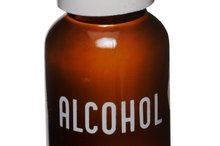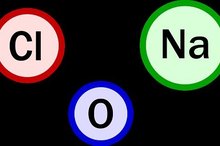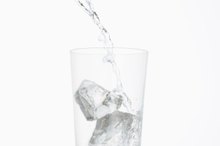What does fact checked mean?
At Healthfully, we strive to deliver objective content that is accurate and up-to-date. Our team periodically reviews articles in order to ensure content quality. The sources cited below consist of evidence from peer-reviewed journals, prominent medical organizations, academic associations, and government data.
The information contained on this site is for informational purposes only, and should not be used as a substitute for the advice of a professional health care provider. Please check with the appropriate physician regarding health questions and concerns. Although we strive to deliver accurate and up-to-date information, no guarantee to that effect is made.
Glycerine Vs. Glycol
Glycerine and glycol can be easily confused because they are both odorless, colorless, syrupy and sweet. But that would be a potentially deadly mistake. Glycerine has many purposes, including use as a food sweetener and preservative, but glycol is highly toxic and is used primarily as an antifreeze in vehicles.
Glycerine
Glycerine is more commonly called glycerol, which can add to confusion because of the similarity between the terms "glycerol" and "glycol." Glycerol is a by-product of the production of soap and the refining of vegetable oils and biodiesel fuel. It is a humectant, which means it attracts, absorbs and retains moisture from the air. For this reason it's a popular ingredient in skin lotions. It is used as a natural sweetener, a solvent, a preservative and a thickening agent. The combination of a glycerol molecule and fatty acids produces the triglycerides that make up most of our dietary fats.
- Glycerine is more commonly called glycerol, which can add to confusion because of the similarity between the terms "glycerol" and "glycol."
- Glycerol is a by-product of the production of soap and the refining of vegetable oils and biodiesel fuel.
Medical Uses
What Toxic Chemicals Are in Rubbing Alcohol?
Learn More
Physicians use glycerol to reduce pressure or fluid in the eye. Glycerol is also used to reduce swelling in the brain in patients with increased pressure in the skull or a brain hemorrhage. Glycerol injections are used to treat a condition called trigeminal neuralgia that affects the trigeminal nerve (one of the cranial nerves) and causes sudden, severe facial pain. The glycerol relieves the pain by damaging the trigeminal nerve fibers. In the form of a suppository, glycerol is used to relieve constipation.
- Physicians use glycerol to reduce pressure or fluid in the eye.
- Glycerol is also used to reduce swelling in the brain in patients with increased pressure in the skull or a brain hemorrhage.
Glycol
Glycol is better known as ethylene glycol 2. It is a synthetic liquid used to make antifreeze and de-icing solutions for cars, airplanes and boats. It’s also a component of ballpoint pens and hydraulic brake fluids. Ethylene glycol is toxic to humans and animals.
- Glycol is better known as ethylene glycol 2.
- It is a synthetic liquid used to make antifreeze and de-icing solutions for cars, airplanes and boats.
Risks
What Are the Dangers of Ethylene Vinyl Acetate?
Learn More
According to the Centers for Disease Control (CDC), ethylene glycol in the air breaks down in about 10 days. If it seeps into water or soil, it breaks down within a few days to a few weeks. The primary way people are exposed to ethylene glycol is by touching or drinking antifreeze. There is also a risk to people who work in industries where they’re exposed to the substance. While it’s very toxic to humans, ethylene glycol may pose an even bigger risk to animals. If it's spilled while antifreeze is being added to a vehicle, animals may drink it eagerly because of its sweet taste.
- According to the Centers for Disease Control (CDC), ethylene glycol in the air breaks down in about 10 days.
- There is also a risk to people who work in industries where they’re exposed to the substance.
Effects
A tiny amount of ethylene glycol will probably not harm humans, but according to the National Library of Medicine, as little as 4 fl 2. oz. may be enough to kill an average-sized man. The CDC states it can damage the kidneys, nervous system, lungs and heart. Ethylene glycol affects the body two ways. It can turn into crystals that collect in the kidneys, and it's an acid that affects the nervous system, lungs and heart. Drinking ethylene glycol causes the same feelings as drinking alcohol, but in a few hours the symptoms will turn into nausea, vomiting, convulsions and possibly coma.
- A tiny amount of ethylene glycol will probably not harm humans, but according to the National Library of Medicine, as little as 4 fl 2.
- Drinking ethylene glycol causes the same feelings as drinking alcohol, but in a few hours the symptoms will turn into nausea, vomiting, convulsions and possibly coma.
Related Articles
References
- Pioneer Thinking: What Is Glycerine?
- National Library of Medicine: Ethylene Glycol Intoxication
- Agency for Toxic Substances and Disease Registry. Public health statement: Propylene glycol. Updated January 21, 2015.
- U.S. Food and Drug Administration. CFR - Code of Federal Regulations Title 21. Sec. 184.1666 Propylene glycol.
- McGowan MA, Scheman A, Jacob SE. Propylene glycol in contact dermatitis: A systematic review. Dermatitis. 2018;29(1):6-12. doi:10.1097/DER.0000000000000307
- Ellington S, Salvatore P, Ko J et al. Update: Product, substance-use, and demographic characteristics of hospitalized patients in a nationwide outbreak of e-cigarette, or vaping, product use–associated lung injury — United States, August 2019–January 2020. MMWR Morb Mortal Wkly Rep. 2020;69(2):44-49. doi:10.15585/mmwr.mm6902e2
- American Lung Association. Health risks of e-cigarettes and vaping. Updated July 13, 2020.
- Ooi B, Dutta D, Kazipeta K, Chong N. Influence of the e-cigarette emission profile by the ratio of glycerol to propylene glycol in e-liquid composition. ACS Omega. 2019;4(8)pp.13338-13348. doi:10.1021/acsomega.9b01504
- National Library of Medicine. National Center for Biotechnology Information. Propylene glycol.
Writer Bio
Sandi Busch received a Bachelor of Arts in psychology, then pursued training in nursing and nutrition. She taught families to plan and prepare special diets, worked as a therapeutic support specialist, and now writes about her favorite topics – nutrition, food, families and parenting – for hospitals and trade magazines.







